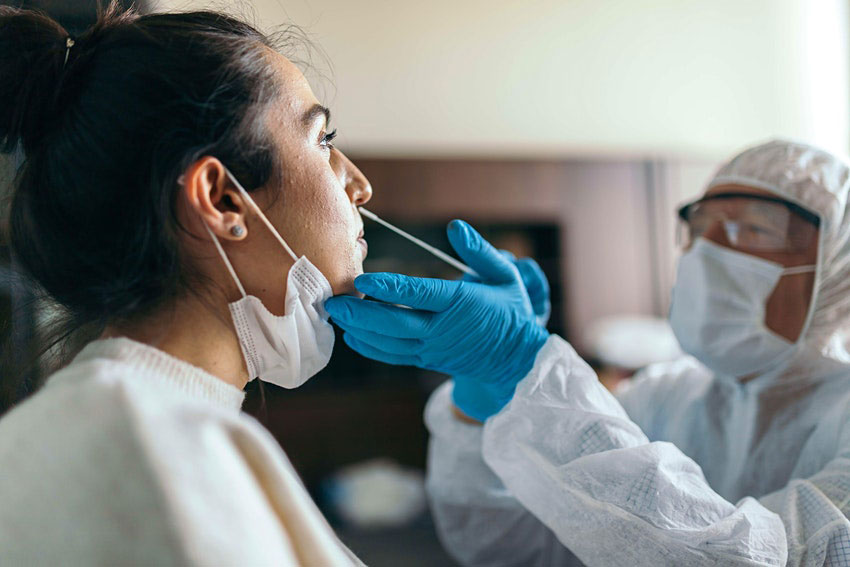
Travelers to the US will need to get a COVID-19 test within 24-hours of travel © Ergin Yalcin/Getty Images
Traveling to the US? Here’s how to meet the new one-day testing rule
TripFalcon December 05, 2021
Last Update: 2024-01-03 22:02:45On December 2, the Biden administration announced that all inbound travelers to the United States must test negative for COVID-19 within one calendar day before their flight—a tactic to try and slow the spread of the Omicron variant.
This change—which takes effect on Monday, December 6—shortens the current testing window for vaccinated people, which previously required they test negative within three days of departure. Only vaccinated international travelers can enter the US, however, unvaccinated US citizens are able to return. The testing window for unvaccinated Americans was previously one day and will remain so. The new rule applies to everyone two years of age and older.
The testing regulation might seem like an impossible task—particularly for those who booked a trip without knowing the new law—but it doesn't have to be. While the next few days may be complicated for some travelers trying to meet the new rules, if you’re planning to travel in the future, mapping out a plan and getting tested within one day of your flight can be an easily-navigable part of your travel itinerary.
"The whole thing is not a big deal," says Michael Holtz, founder and CEO of the luxury travel agency SmartFlyer. When the US enacted the three-day testing rule roughly one year ago, Holtz notes that testing options were harder to find. Today, they're ubiquitous.
"Even if a client is hiking the Himalayas, they can get their test done in 24 hours," he says.
Here's everything you need to know about navigating the new testing requirement.
What kind of test do I need?
All travelers entering the United States must take a SARS-CoV-2 viral test, which includes antigen and nucleic acid amplification tests (NAATs). The most common NAAT is a PCR test, the gold standard for diagnosing COVID-19. If you're uncertain whether or not the US will accept your test, check the CDC's website for confirmation.
Different tests yield different wait times, ranging from fifteen minutes to several days. With a tight one-day turnaround, it's necessary to take a test that delivers results within the appropriate window.
For travelers taking a rapid at-home test, remember to follow the CDC's guidelines: a telehealth professional must be able to confirm your identity, observe the test, and authenticate the result. Abbot BinaxNOW and Ellume are two of the rapid at-home tests approved by the Federal Drug Administration. Visit their websites to purchase kits and set up a telehealth appointment.
Regardless of what test you use, all travelers must obtain documentation of their results before boarding their flight. This documentation may come as a QR code, text, email, or piece of paper. If you recently recovered from COVID-19, you can also show your positive COVID-19 test result on a sample taken no more than 90 days before departure and a letter from a licensed healthcare provider clearing you for travel.
Consider that these are only the requirements for travelers to the mainland US. Hawaii, for example, only accepts PCR tests from a specified list of trusted providers, and neighboring Canada does not accept antigen tests. Stay up-to-date on local laws by checking the health department website for the state or territory you're visiting.
How do I get a COVID-19 test while traveling outside the US?
There are four locations to consider when getting tested abroad.
Some hotels provide COVID-19 tests
The first is at the hotel or resort where you're staying. "A lot of hotels are set up to handle testing," says Holtz. Call ahead or check the hotel's website to see if there's on-site testing. Next, ensure the test meets US requirements. If the hotel doesn't provide testing, the concierge or front desk staff should be able to direct you to the nearest testing facility.
Visit a local pharmacy
For those who aren't staying at a hotel, head to a local pharmacy. Although not all pharmacies provide on-site testing, the employees should also be able to point you toward an accessible medical clinic or testing site.
Check if your airport provides testing
You'll also find coronavirus testing at many international airports. Check the Business Traveller website for a comprehensive list of airports and their testing locations, operating hours, test costs, and the length of time to receive results. On a recent trip through Florence, Holtz used a testing facility in the airport parking lot and received his results within twenty minutes.
Take an at-home test
Lastly, traveling with an at-home test kit is the best way to offer anxious travelers peace of mind. Getting tested at your vacation rental—at a time you choose and in your preferred language—can be a soothing antidote to long lines at foreign pharmacies or airports. However, this only works if you have a strong WiFi connection or cell service to support a telehealth video conference.
Other tips for finding a test
Cut down search time for a testing location by consulting the internet. Test for Travel, an international COVID-19 testing database with an easy-to-use interface, offers information on global requirements, testing locations, available test types, and processing time.
"We have about 10,000 locations listed in over 95 countries right now," says Test for Travel's founder and CEO, Julien de Bats. The website only shows locations that process tests in 72 hours or less and indicates if the site offers same-day, next-day, or 15-minute test results. Julien says that rapid PCR tests aren't as widely available internationally as in the US, making antigen tests the easiest way to fulfill the new 24-hour testing requirement.
When should I book my test?
Booking a COVID-19 test is as vital to the trip-planning process as booking a hotel room. "It's an addition to your travel checklist," says de Bats. Finding a clinic that meets the one-day rule can be complicated, and getting tested on weekends or holidays might leave you few options. Testing prices can range from tens to hundreds of dollars, too, and if you weigh the possibilities, you'll likely save money.
The bottom line? Make a plan now and worry less later. Don't wait until the last moment and assume everything will work out.
Once you've identified how and where you're going to get tested, figure out the logistics. For in-person testing, map out how you'll get to the site. For at-home testing with a telehealth professional, ensure you have access to reliable cell service or WiFi. If your testing site doesn't require appointments, factor in plenty of time for a visit. It's better to prepare for the worst and be surprised by a frictionless experience.
What if I don't receive my results before I fly?
"Start by contacting the laboratory or location where you got tested," recommends de Bats. Then, if your results still aren't ready, contact your airline. Most airlines can assist by finding you an alternative testing option, changing your departure date, or booking a flight to a location where you can get tested before entering the United States. Traveling with an approved at-home test kit can often alleviate these concerns.

